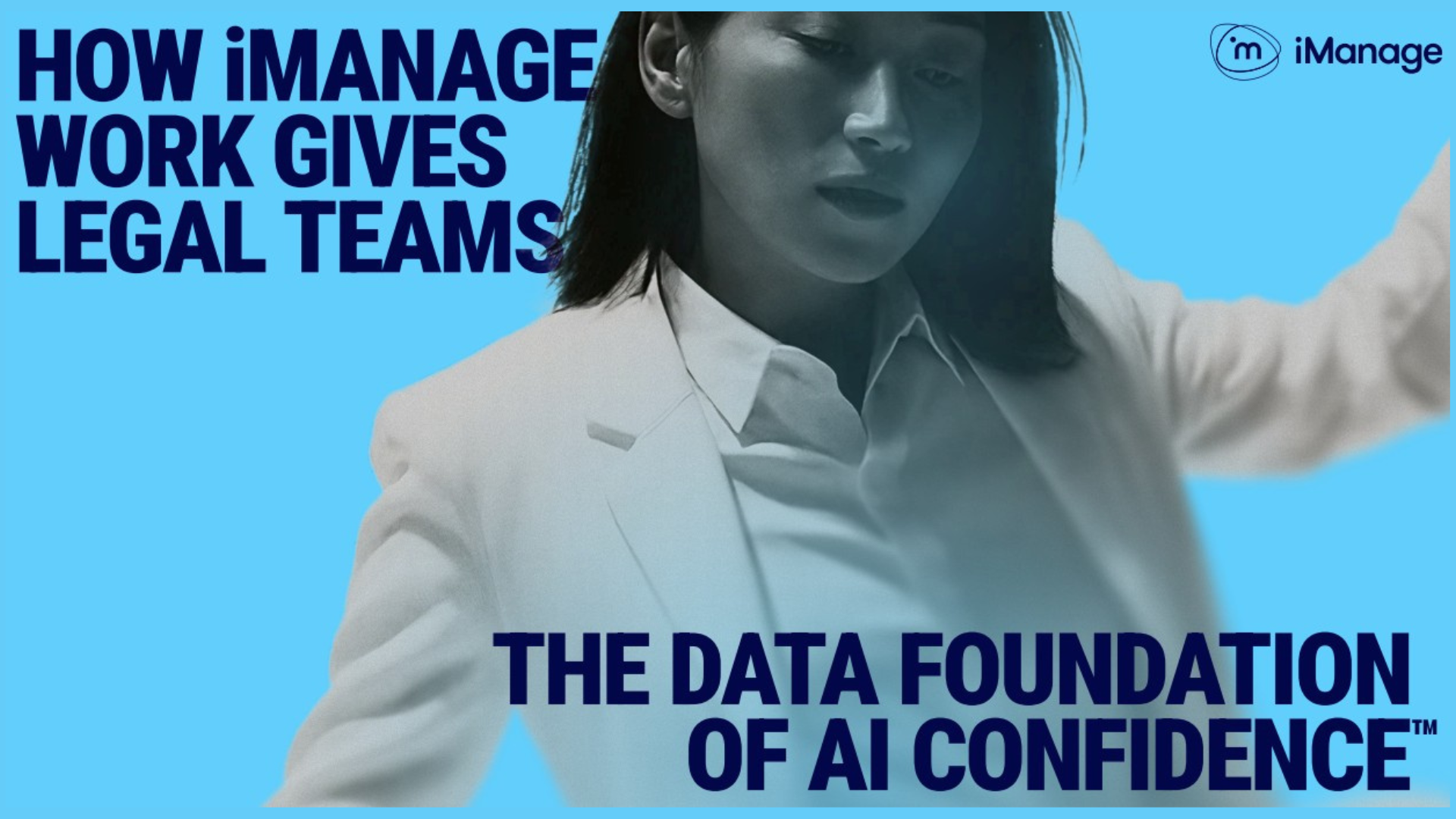Sponsor Content Created With iManage
Yes, legal AI. But what can you actually do with it? Let’s take a look…
Legal AI is a knowledge multiplier that can accelerate research, sharpen insights, and organize information, provided legal teams have confidence in its transparent and auditable application

Artificial intelligence (AI) is everywhere — in headlines, vendor pitches, conference panels, and strategic plans. But for many law firms and legal departments, the question remains: What can you actually do with it?
The answer isn’t just technical. It’s strategic.
AI is not a replacement for human intelligence. It’s a knowledge multiplier. When properly integrated into legal workflows and applied to appropriate use cases, AI can elevate the work of legal teams — accelerating research, sharpening insights, and organizing information in new and better ways. But the real magic happens when legal teams have confidence in their AI technology: when they understand how it works, trust its outputs, and see it as a partner in their practice.
AI-powered knowledge acceleration
Legal research is foundational — but it’s also time-consuming. Junior associates spend hours analyzing and comparing multiple documents. Experienced lawyers rely on institutional memory and precedent. Knowledge managers curate repositories and templates. It’s a complex, manual ecosystem.
AI changes the game.
With natural language processing (NLP) and semantic search, AI can surface relevant materials in seconds — not hours. It can understand context, intent, and nuance, going beyond keyword matching to deliver conceptually aligned results. It can suggest related cases, flag contradictory rulings, and even summarize holdings.
“AI streamlines the legal document review process by automating tasks like eDiscovery, document summarization, and drafting, helping lawyers save time and improve efficiency,” according to the American Bar Association in its ‘How AI Enhances Legal Document Review’ article.
AI-powered knowledge acceleration allows lawyers to start from a higher baseline — focusing on strategy, interpretation, and advocacy rather than mechanical search. It democratizes expertise, making deep knowledge accessible across the team.
Document comparison for legal insights
Contracts, pleadings, and policies — these documents are the lifeblood of legal professionals. But comparing them manually is error-prone and tedious. Spotting subtle differences in language, structure, or risk exposure takes time and experience.
AI excels at document comparison.
Modern tools can ingest multiple versions of a document — say, a client’s standard non-disclosure agreement (NDA) and a counterparty’s markup — and instantly highlight differences. They can flag missing clauses, altered definitions, and inconsistent terms. They can benchmark documents against firm templates or market standards. And they can do it across hundreds of files at once.
AI-powered comparison can also deepen insight, helping lawyers understand what’s changed, why it matters, and how to respond. It supports negotiation, risk assessment, and compliance — all with greater speed and precision.
AllAboutAI reports that “lawyers save up to 32.5 working days annually using Generative AI (GenAI), with 65% reporting 1-5 hours saved per week” and “AI achieves 94% accuracy in NDA review tasks compared to 85% for human lawyers.”
AI-augmented legal insights
Legal reasoning is complex. It involves interpreting facts, applying law, and anticipating outcomes.
By analyzing patterns across cases, filings, and outcomes, AI can surface trends and probabilities. It can suggest likely judicial behavior, identify common litigation strategies, and estimate timelines or costs. It can help lawyers spot emerging risks, benchmark performance, and make data-informed decisions.
This is especially powerful in litigation analytics, regulatory monitoring, and portfolio management, where AI equips lawyers with the information to make better calls.
Smart data organization in law firms
Law firms generate mountains of data: emails, memos, contracts, pleadings, transcripts, and notes. Much of it is unstructured, scattered across systems, and hard to retrieve. Traditional document management systems struggle to keep up.
AI brings order to chaos.
With intelligent tagging, clustering, and classification, AI can organize data dynamically. It can group documents by matter, topic, jurisdiction, or risk level. It can extract key entities — parties, dates, obligations — and link related materials. It can support granular search, automated filing, and contextual retrieval. This transforms how firms manage knowledge. Instead of relying on folder structures and manual tagging, they gain a living, searchable, interconnected repository. It supports collaboration, reuse, and strategic insight — turning data into a true asset.
Confidence is the catalyst
All of these use cases depend on one thing: confidence.
Legal teams won’t use AI tools they don’t trust. They won’t rely on outputs they can’t explain. And they won’t embrace systems that feel like black boxes.
That’s why successful AI adoption starts with transparency, training, and alignment. In its Five Principles of AI Confidence, iManage explains, “Lawyers must be able to explain and defend every decision. If AI outputs can’t be traced or justified, they’re unusable in legal contexts. Transparency builds trust and ensures the defensible use of AI.”
Firms must choose tools that are explainable, auditable, and grounded in legal logic. They must involve lawyers in design and deployment. They must provide clear feedback loops, governance frameworks, and ethical safeguards. Ultimately, they must build a culture of experimentation and learning.
When lawyers understand how AI works — and see it consistently deliver value — they begin to trust it. And when they trust it, they use it. That’s when AI becomes a true multiplier.
AI as a legal ally
Legal AI empowers lawyers. It is a knowledge multiplier that can elevate research, sharpen insights, and organize information in transformative ways.
Strategic AI deployment doesn’t necessarily represent a seismic shift, but it does need intentionality and targeted use cases, according to Laura Wenzel, global marketing and insights director at iManage.
“Each implementation causes another internal barrier to fall. Confidence grows. Adoption broadens. And from there, the gains begin to compound exponentially,” she says in an iManage blog post.
“The firms already generating material returns from AI have never treated it as a standalone solution. They’ve embedded it into core workflows, aligned it with specific business goals, and cultivated a culture that recognizes AI as a formidable tool for accelerating professional growth,” Wenzel adds.
“From a technical perspective, these firms have deployed governed systems that maintain data integrity, provide clear audit trails, and integrate seamlessly into daily legal work. Culturally, they’ve equipped their lawyers with powerful tools that they’ve learned to understand, trust, and want to use. The outcomes are rich and plentiful.”
It’s clear then that the real value comes when teams trust the technology. When they see it as a partner, not as a threat. So, yes, you can do quite a lot with legal AI — if you start with the right mindset, the right foundation, and the right use cases.
Sign up today and you will receive a free copy of our Future Focus 2025 report - the leading guidance on AI, cybersecurity and other IT challenges as per 700+ senior executives
-
 Trump's AI executive order could leave US in a 'regulatory vacuum'
Trump's AI executive order could leave US in a 'regulatory vacuum'News Citing a "patchwork of 50 different regulatory regimes" and "ideological bias", President Trump wants rules to be set at a federal level
-
 TPUs: Google's home advantage
TPUs: Google's home advantageITPro Podcast How does TPU v7 stack up against Nvidia's latest chips – and can Google scale AI using only its own supply?
-
 The Data Foundation of AI Confidence
The Data Foundation of AI Confidencewhitepaper
-
 Tired of legal AI tools that overpromise but underdeliver? The secret to success is in your firm’s data
Tired of legal AI tools that overpromise but underdeliver? The secret to success is in your firm’s dataSponsored Don't let legal AI tools overpromise and underdeliver: the secret to success isn't the software, but building a secure, stable, and connected data foundation that transforms your firm's complex, siloed information into structured knowledge.
-
 What can AI do to empower those working in the legal sector today, tomorrow, and beyond?
What can AI do to empower those working in the legal sector today, tomorrow, and beyond?Supported AI is transforming the legal profession — from streamlining today’s workflows to shaping tomorrow’s strategies. For firms, the choice is clear: embrace trusted AI tools now or risk falling behind in a rapidly evolving landscape
-
 AI in the legal sector: How to separate the signal from the noise
AI in the legal sector: How to separate the signal from the noiseSupported From contract review to litigation strategy, AI promises efficiency. But with so much noise in the market, legal professionals must know how to spot tools that deliver real value
-
 How AI can help rather than hinder knowledge workers in the legal profession
How AI can help rather than hinder knowledge workers in the legal professionSupported AI won’t replace lawyers — it empowers them. Free from routine tasks, legal pros can focus on strategy, judgment, and client success
-
 AI legal confidence: What is it and how do you get there?
AI legal confidence: What is it and how do you get there?Supported AI is reshaping legal practice, but doing so successfully comes down to building trust and confidence...